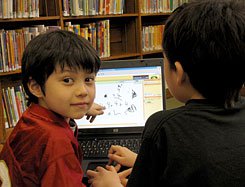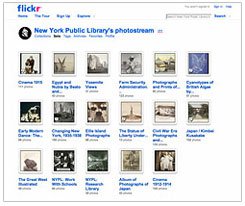Virtual Libraries Are Teaching Treasures
There’s more than just e-books to check out at the online library.
Your content has been saved!
Go to My Saved Content.
When Lisa Woodruff set out to design a lesson for her seventh- and eighth-grade class on Lois Lowry's novel The Giver, she hit the stacks for inspiration. But she didn't visit her small-town New Hampshire library. Instead, Woodruff tapped the country's largest collection, the Library of Congress, from her personal computer.
At the library's Web site, Woodruff was able to search a digitized collection of books, music, and video clips, browse databases, and reference prepared lesson plans. "I can work from home when developing curriculum -- I don't need to go to the actual library," says the science and literature teacher, who works at the Lincoln Akerman School, in Hampton Falls, New Hampshire.
As Woodruff has found, virtual libraries can be a teacher's greatest aid. They're convenient and current, they open the door to more resources than are locally available, and they appeal to tech-savvy kids. "Students today are very comfortable with navigating online information," she notes. "And the technology keeps them interested, with graphics and interactive capabilities."
More Than E-Books
What visitors will find at an online library might surprise them. The sites are no longer merely massive infodumps of electronic text. Harnessing new technologies, libraries are posting sound and video files, blogs, and podcasts. A single search at a library's Web site can turn up a newspaper article, a postcard, a book, a sound clip, a poster, and a fragment of film. The ability to access all these types of media from one site is a boon for educators.
Not only can teachers and students download different forms of data, they can also access them on almost any platform. Libraries now offer outposts on YouTube and Flickr and from iTunes, and there are even libraries in the online role-playing game Second Life.
It may be cooler to a teen to check out an e-book, take a class on podcasting, or participate in a book discussion in an online game rather than at the local library, but the end result is the same: They're learning. Making information available on sites that teachers and students are already familiar with and that have kid cred keeps libraries and their holdings more accessible and relevant.

Among the most aggressive libraries in this space is the New York Public Library. It has joined Facebook, posted some 1,300 photos on Flickr, and begun offering content on iTunes U, and it recently launched a collection of online videos through YouTube. "Our focus is to make the resources of the New York Public Library more readily findable and usable by the communities we serve," says library representative Jennifer Lam.
The library's Treasures of the New York Public Library video series includes three- to-five-minute videos covering everything from the 1939 World's Fair and the inner workings of the piano to the Harlem Renaissance.
Taking this idea even further, the library is working on digitizing additional images that can be posted on YouTube using VoiceThread software, which merges images, text, and audio. Students will be able plug pictures from the library's archive into VoiceThread slide shows. Then they can create avatars of themselves talking about the images, add relevant information, draw on the images, and accept comments from their classmates. (See Edutopia.org's article about VoiceThread.)
"We're hoping that teachers look at our digital collections and don't just say, 'This is interesting,' but instead actually take our pictures and have their students make something new from them," explains library digital producer Andrew Wilson.
Another ambitious virtual library project is Europeana, an ongoing effort to digitize the archive, library, museum, and audiovisual collections of all the European Union's 27 nations through a single portal by 2010. "It won't matter which European country holds an item or whether it's in a library, museum, or archive," says Europeana spokesperson Jonathan Purday. "It will be possible to find it and bring it into context with other related materials."
Preserving the Past, Digitally
But although such primary sources are in great demand, teachers need additional resources to frame the collections and make effective use of them. After all, a library is more than the sum of its books. At its heart, it is a community enclave for lively interaction and learning. Most of the country's public libraries now offer tutoring services, free computer use, and grade-specific reading lists, plus databases in virtually every subject; some provide teacher zones that include targeted lesson plans and ready-made ancillaries to cut down on teacher prep time.
"We do workshops, and teachers are often surprised by what we have," says Carol Katz, assistant coordinator of children's services at New York City's Queens Library. To remedy this information gap, Katz and her staff work to educate the educators on just what their library offers, including vast online databases that, Katz says, are rich mines for student research projects and for lesson preparation.
"Teachers come to us for books and book lists," adds the New York Public Library's Andrew Wilson. "I'm not sure they know about the e-books, videos, and images that they can get online."
New Hampshire teacher Lisa Woodruff is familiar with some of these resources. For her class on The Giver, she used the Library of Congress's American Memory Web site. An offshoot of the library's larger site, the American Memory portal organizes the library's U.S. history holdings, including written words, sound recordings, still and moving images, prints, maps, and sheet music. Specifically designed for teachers, the site provides lesson plans and activities as well as tips for incorporating the content into the classroom.
Woodruff used the site to catalyze a discussion contrasting American society with the one in The Giver, in which individuals readily surrender memories in the belief that past events are burdensome, painful, and best forgotten.
"The site allows the students to see how much time and energy our society spends recording and preserving our history," observes Woodruff. "It's a great way to get the students to consider the purpose of documenting history and the powerful tie between a society's past and its future."
Where better to explore that tie than at the virtual library? Libraries have always been archives of our collective past. Now, with the advent of multimedia virtual libraries, they appear also to be heralds of our future.